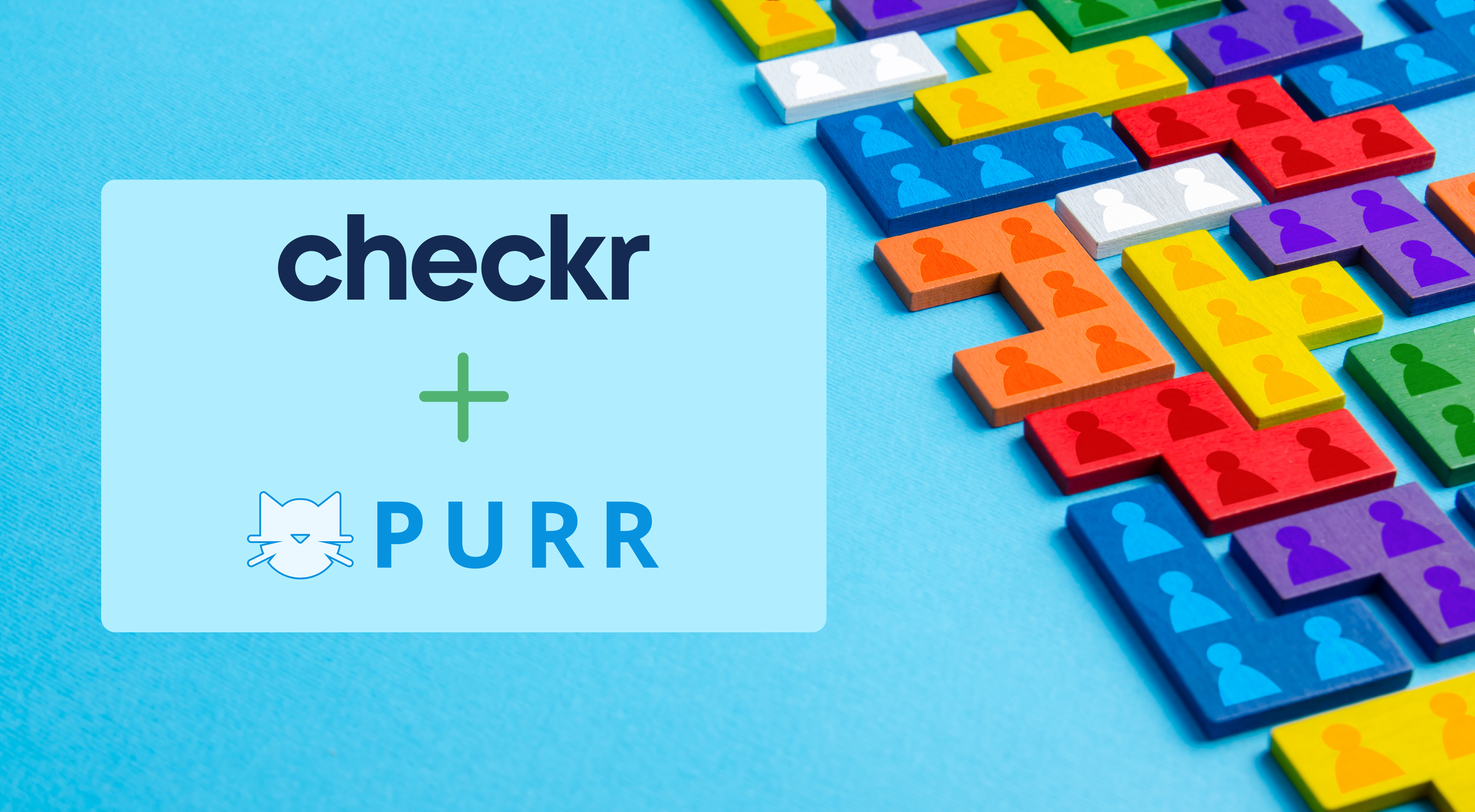
When you’re hiring, you want to make sure you’re bringing the right people into your team. After all, one wrong hire can put your entire organization at risk. This means not just checking off boxes but really ensuring that your new hires can walk the talk. That’s where knowing how to run a background check on someone comes into play.
With PURR’s automated background checks, you can streamline your candidate screening process and make smarter hiring choices. But more on that in a minute. First, we’ll walk you through the simple steps of how to do a background check on someone whose resume looks promising.
You’ll learn about the different types of background checks, how long they take, and the importance of thorough screening for making informed decisions.
What Is a Background Check?
A background check is a review of a person’s commercial, criminal, and (sometimes) financial records. Essentially, it’s a way to verify the information provided by a job candidate and ensure there are no red flags. It serves as crucial guidance for employers, along with reference checks and candidate interviews.
When screening a candidate for employment, you need to adhere to background check laws – regulations designed to protect candidates’ privacy and ensure a fair hiring process. When conducting background checks, it’s crucial to follow consent requirements, comply with the Fair Credit Reporting Act (FCRA) and candidate rights, and avoid any employer discrimination practices.
Additionally, be aware of state-specific laws that may impose further restrictions on what information can be reviewed or how it can be used. Keeping these legal requirements in mind ensures your background check process is both ethical and compliant, safeguarding your company from potential legal issues. Consult your in-house legal counsel for more details.
What Does a Background Check Consist Of?
A comprehensive background check covers various aspects of a candidate’s history to ensure they are a good fit for your company. Here are the main components of a universal background check:
- Identity Verification: Ensuring the candidate is who they claim to be and prevent fraud, often through document verification and cross-referencing with public records.
- Criminal Background Checks: Criminal record checks inspect past criminal convictions to ensure a safe and compliant workplace. Reviewing public records about the candidate’s criminal history also protects you from negligent hiring lawsuits.
- Driving Record Checks: Reviewing an individual’s history of traffic violations, accidents, and license status. For roles involving driving company vehicles or requiring a clean driving record, this ensures the candidate meets the necessary criteria and can safely perform their duties.
- Drug screening: Used for determining if a candidate has used illegal substances, common in industries where safety is paramount, such as transportation, healthcare, and manufacturing. By screening for drug use, employers can maintain a safe and productive work environment while minimizing risks associated with substance abuse.
- Employment Verification: Check for employment history – confirm previous employers, job positions, durations, and reasons for leaving. Run a skills verification to ensure the candidate has the skills and experience listed on their resume.
- Educational Background Verification: Confirm the educational background and authenticity of academic credentials and qualifications listed by the candidate.
- Credit Checks: Evaluating the candidate’s payment history and overall financial behavior (a good financial track record is a good indicator in general and can be crucial for roles involving financial duties.)
- International Background Check: Checking the candidate’s history in countries they have previously lived or worked in can be crucial for global companies.
How Long Does It Take to Do a Background Check?
The duration of a background check process can vary based on several factors. Here’s a breakdown:
- Basic checks: Identity and employment verification can be completed within 1-3 business days.
- Criminal history and public records: These can take 3-5 business days, depending on the jurisdiction.
- Education and international checks: These might take longer, typically 7-14 business days, due to the need to contact multiple institutions and verify documents.
With PURR’s automated system, many of these checks can be expedited and streamlined, providing instant and reliable results to keep your hiring process on track without the need for extensive resources.

Types of Background Checks
Understanding the different types of background searches is crucial for developing effective background check strategies for your specific needs. For instance, a standard background check typically covers criminal history and employment verification, but more specialized checks, such as those including credit checks or international background verifications, may be necessary, depending on the role.
Tailoring your approach and company background check policy to your needs ensures you get comprehensive insights into your candidates, enabling smarter hiring decisions. Here’s a closer look:
- Pre-employment Background Checks
These are the comprehensive, basic background checks conducted before making a hiring decision. They can cover any of the main components we discussed above, depending on the type of background check you need.
- Post-Hire Background Checks
Post-hire background checks are conducted after an individual has already been hired and started working for a company. While pre-employment background checks focus on verifying information provided by candidates before they are hired, post-hire checks serve different purposes:
- Ongoing Employee Monitoring: Ensuring employees maintain eligibility for their positions. This could include periodic criminal background checks or drug screenings, particularly for roles that involve handling sensitive information, motor vehicles, or working with vulnerable populations.
- Promotions or Transfers: Verifying employee suitability for a new position. This could involve reviewing their work history, performance evaluations, and any relevant qualifications or certifications.
- Compliance with Industry Regulations: In some industries, such as finance or healthcare, employees may be subject to ongoing background checks to ensure compliance with industry regulations. This could include checks to verify professional licenses or certifications, as well as checks for any criminal activity that could impact their ability to perform their job duties.
- Mitigating Risk: Periodical checks for identifying any issues that may have arisen since the employee was hired. This could include conviction records, violations of company policies, or other behavior that could pose a risk to the company or its employees.
Why Use a Background Check Company When There’s PURR?
Partnering with a background check company can significantly enhance your employee background checks by providing access to specialized expertise, resources, and technology, ensuring thorough and accurate screening processes while saving time and effort for your HR team.
However, today, there’s no need to pay for background-checking services when you have generative AI-powered all-in-one recruitment software such as PURR at your fingertips. Background check professionals sure know how to thoroughly comb through the candidate pool, but using cutting-edge technological resources will make you one and save you time and money.
- Efficiency: Automated checks save time and reduce manual effort.
- Accuracy: Advanced algorithms and proprietary generative AI ensure thorough and accurate checks.
- Compliance: Staying compliant with legal and regulatory requirements is simpler.
- Peace of Mind: Knowing you’ve done your due diligence helps you make informed hiring decisions.
How to Do a Background Check on Someone Using PURR’s Generative AI: A Step-by-Step Walkthrough
The general process for background checks typically involves gathering information from candidates, selecting the appropriate types of checks, conducting the screenings, and reviewing the results. However, it can be tailored to meet your specific needs or streamlined with the help of advanced AI recruitment tools like PURR.
Here’s a step-by-step guide on how to run a background check on someone using PURR’s features:
- Initial Screening
Start with the candidates’ resumes and references. First, use PURR to initiate resume filtering and speed up this process for candidates eager to get interviewed for your job posting. Once a candidate progresses to the second-to-last interview round, our system kicks off reference checks automatically, if necessary.
Depending on your preferences, this could entail sending candidates a questionnaire to complete or gathering their responses through an AI dialer. PURR then assesses the reference responses automatically, categorizing them as positive, negative, or neutral. Whether it’s skills verification or culture fit, our generative AI streamlines the resume and reference-checking process, arming you with valuable insights.
- Identity, Employment, and Education Verification Check
If needed, confirm the candidate’s identity using official documents and cross-referencing public records. Verify past employment and academic credentials.
- Criminal Background Check
Conduct thorough checks of local and national databases for criminal records. Include international checks if applicable.
- Credit Checks
If relevant to the position type, perform a credit check to evaluate financial history.
- Review and Decision
Compile all the information gathered and use PURR’s insights to make fair and informed employment decisions.
Streamline Candidate Screening with Generative AI
Lengthy background checks done manually by your HR team or hiring a costly qualified background check provider are a thing of the past. By leveraging PURR’s features, you can customize the process to fit your requirements, allowing you to focus on other aspects of the hiring process while PURR handles the heavy lifting of candidate screening, arming you with complete background check reports.
- Speed: Rapid processing times keep your hiring process on track.
- Accuracy: Advanced AI ensures precise and reliable information.
- Simplicity: Easy-to-use interface allows HR teams to conduct thorough checks without hassle.
- Compliance: Stay on the right side of legal and regulatory requirements.
- Comprehensive Reports: Get detailed insights into a candidate’s background, helping you make better decisions.
Final Thoughts
In today’s competitive job market, making informed hiring decisions fast is more important than ever. Knowing how to do a background check on someone ensures you’re bringing the cream of the crop onboard. By following this guide, you’ll have a comprehensive understanding of how to run a background check on someone and also leverage PURR’s capabilities to make informed and effective hiring decisions.
Using PURR’s generative AI-powered recruiting software for the entire talent acquisition process, including automated background checks, you can streamline tedious tasks, save time, and focus on what really matters – finding the right fit for your company.
Don’t leave your hiring decisions to chance. Whether you’re a business or a recruiting agency, empower your HR team with PURR and make the smart choice for your next hire. Book a demo to get a guided walk-through of its capabilities, or try out all the features first-hand by getting a free trial. Got any questions? We’re here for you.
Get in touch today!


